Pothos, a.k.a. devil’s ivy, is a popular indoor plant widely known for its low maintenance and air-purifying properties.
But, can pothos live outside?
It’s important to know whether this wonderful plant can be grown and live outside without any problems. As these plants are native to tropical regions, they can survive and even thrive when grown outside under similar conditions.
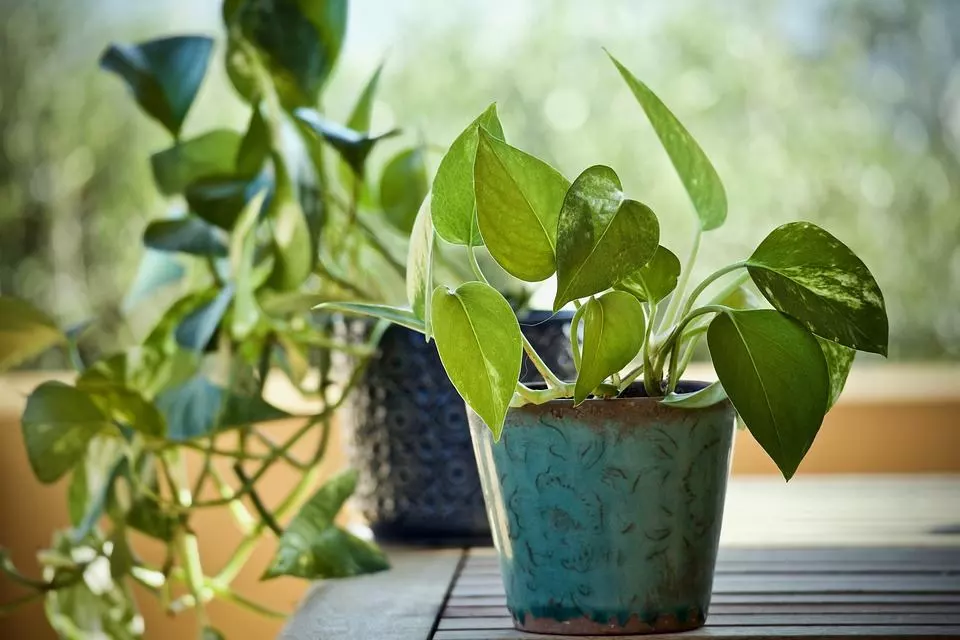
In this article, we’ll provide you with all the essential information you need to know about growing pothos outside.
We’ll cover a range of topics, such as whether it’s even possible, the factors that determine its survival, the advantages and disadvantages, how to prepare it for outdoor living, and common problems and solutions.
Table of Contents
Can Pothos Plant Live Outside?
Pothos plants are native to tropical regions, so they enjoy a range of conditions, especially the sunshine. They are even accustomed to growing in shaded areas where they may have their sunlight filtered by bushes, trees, and even rocks.
Therefore, they can survive and even thrive when grown outside under similar conditions. Whether your pothos plant can live outside depends on several factors, including temperature, light, soil type and condition, humidity, pests, and diseases, and the ideal climate for the plant.
Let’s look at how they fare in the swings of seasons and the conditions mentioned in detail.
Can Pothos Live Outside in Summer?
Pothos plants can live outside and thrive pretty well in summer if they are not exposed to direct sunlight for extended periods.
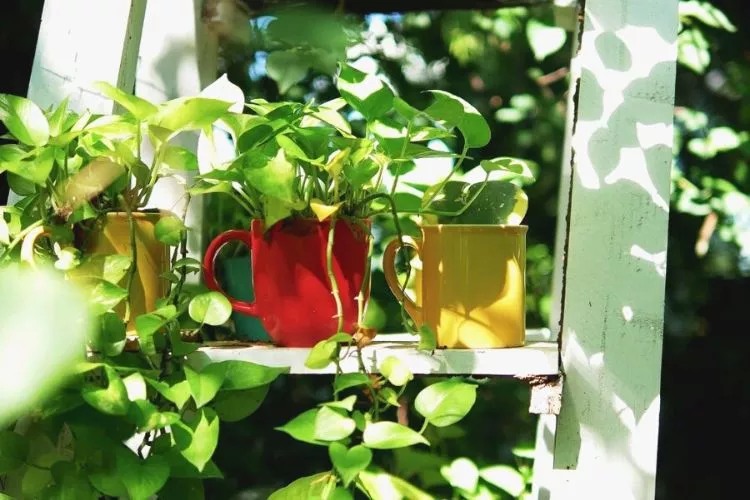
Direct sunlight tends to scorch the leaves and cause them to wilt, especially from midday onwards when the heat may become more intense. It is best to place your pothos plant in a shaded area with indirect sunlight or filtered light to avoid damage to the plant.
Can Pothos Live Outside in Winter?
Pothos plants are sensitive to cold temperatures and cannot tolerate frost. The moisture inside the leaves and stem will freeze, and the cell walls will explode if left too long without the chance of thawing out.
You should avoid growing your pothos plants outside if you live in a region with cold, harsh winters.
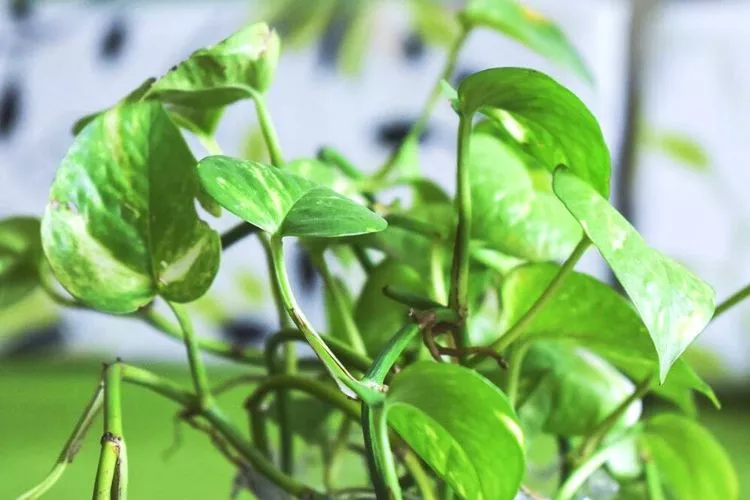
However, if you live in a warmer climate where temperatures don’t drop below 50°F (10°C), you can grow your pothos plant outside year-round.
Winters can be different depending on where you live, so it’s a good idea to address this before planning to grow a pothos plant.
Factors that Determine Pothos Plant’s Survival Outside
A range of factors determines whether your pothos plant can survive outside. These include fluctuating temperatures, amount of sunlight, soil type and condition, humidity, pests, diseases, and even the ideal climate for the plant. Let’s have a look at these factors in some detail.
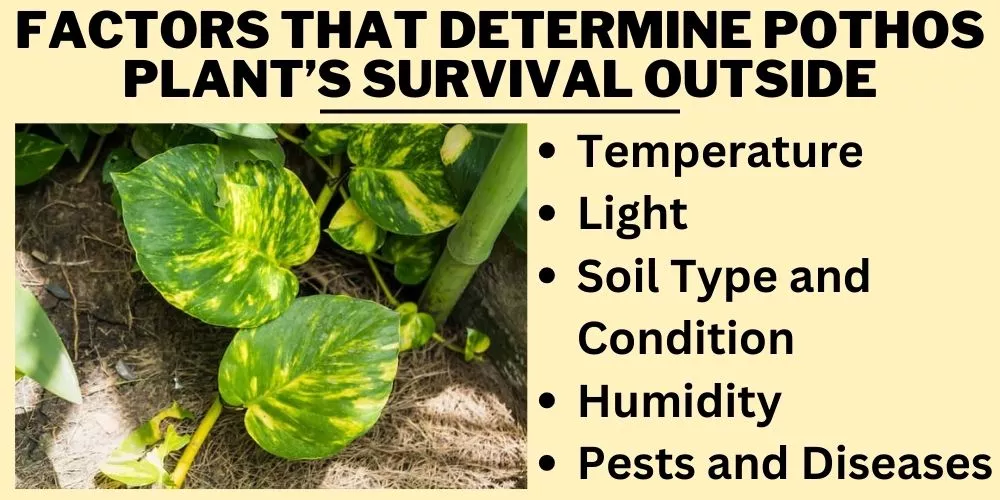
Temperature
Pothos plants thrive best when temperatures are between 65°F – 85°F (18°C – 29°C). They can tolerate slightly higher temperatures, but prolonged exposure to extreme heat can damage the plant.
They can dry out and wilt. On the end of the scale, they can’t tolerate frost or temperatures below 50°F (10°C). As mentioned, the moisture in the plant will freeze up and burst the cell walls, which causes irreparable damage.
Light
Pothos plants prefer bright, indirect light but can also grow in low light conditions. They don’t tolerate direct light as it tends to dry them out much faster, leading to dehydration problems.
When growing pothos plants outside, it’s a good idea to place them somewhere where they receive shade, indirect sunlight, or filtered light.
Soil Type and Condition
Pothos plants prefer a well-draining soil with all the goodness of rich organic matter. Using a mix that includes materials such as peat moss, perlite, and compost is advantageous for pothos plants that are grown outside. These materials assist in retaining moisture while minimizing the risk of the soil becoming waterlogged.
Other suitable soil types for outdoor pothos plants include sandy loam or clay loam, provided that they are well-draining. Clay is not usually recommended but depends more on how loamy the clay is when prepared.
It’s important to avoid heavy, compacted soils that may restrict root growth and cause the soil to become waterlogged.
Simply adding some sand, gravel, or any other coarse material to the soil mix can help vastly improve drainage. Keep in mind that the soil mix should always be moist but not flooded, which leads to waterlogging. This will prevent ailing issues such as root rot from occurring.
Humidity
Pothos plants prefer humidity levels that are in the mid to high range. When growing these types of plants outside, aim to keep the soil moist and the leaves misted to maintain the ideal humidity level.
Slight fluctuations in temperature and wind can alter the humidity dramatically, so it’s always ideal for taking preventative measures.
Pests and Diseases
Pothos plants are susceptible to various pests and diseases that can affect their overall health and survival. The most common pests that can infest and cause damage to pothos plants include spider mites, mealybugs, and scale insects.
These pests can cause damage to the leaves, stems, and roots of the plant and, if left unchecked, can lead to the plant’s death.
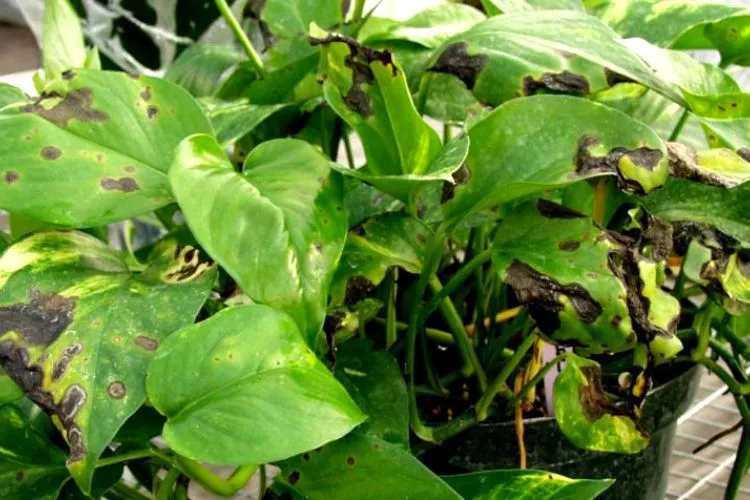
Let’s have a look at how to identify them and the potential damages they may cause in detail:
Spider Mites:
These little guys are super hard to see with the naked eye. Because of this, they can cause significant damage to your pothos plant when you don’t even know they are there in the first place. They snack on the leaves, which causes them to turn yellow and brown.
In severe infestations, leaving the leaves untreated will cause them to fall off. Spider mites also produce a sticky webbing that can cover the leaves and stems of the entire plant.
Mealybugs:
Mealybugs have a soft exterior; they are white and waxy and are much easier to spot. These small pests are usually found hiding on the undersides of leaves and along the stems of pothos plants.
They like to munch on the sap that these plants produce; this type of suckle feeding causes the leaves to turn yellow and result in wilting. Mealybugs also produce the sticky substance that we refer to as “honeydew.” This substance can also attract other pests and cause the formation of fungal growth.
Scale Insects:
Scale insects are also quite small. They have a round, brown or black body. Their method of destruction involves attaching themselves to the stems and leaves of the pothos plant and sucking out the sap.
As a result, the leaves turn yellow and eventually fall off. Scale insects also produce their type of honeydew, which attracts other damaging pests and causes fungal growth and subsequent infections.
In addition to sap sucking pests, the pothos plant is also susceptible to a range of diseases that can ultimately affect its growth and overall survival. Root rot is one of the most common and damaging diseases that can affect a pothos plant.
Root rot is usually caused by overwatering and poor soil drainage.
Each problem amplifies the other, so it’s important to get both aspects right when planting. Root rot can cause the roots to rot, leaving the plant to wilt and then die. Some other diseases are less prevalent but can still affect Pothos if not mitigated.
Let’s have a look at some of the other diseases that Pothos are susceptible to:
Fungal Leaf Spot:
This type of disease is usually caused by various fungi that tend to infect the leaves of a plant. The fungi thrive in warmer, more humid environments and spread via splashing water, wind, or even gardening tools that are already infected.
Other plant management errors, such as overwatering or having poor air circulation around the plant, can also contribute to the rise and takeover of fungal leaf spots.
The symptoms of fungal leaf spots include small, circular, or irregular-shaped leaf lesions that may have a water-soaked appearance.
Furthermore, the leaves can turn yellow, brown, and black, depending on how far the disease has advanced. In severe cases, the leaves can even start falling off, leaving the plant stunted.
Fungal leaf spots can be mitigated by practicing good sanitation within the garden environment. This includes avoiding overhead watering, providing good air circulation, and promptly removing and destroying infected leaves when spotted.
Bacterial Blight:
Bacterial blight is caused by a bacterial infection known as Xanthomonas campestris. It can affect the leaves, stems, and roots by entering any openings, wounds, and damaged tissue of the pothos plant. Once it enters, it multiplies and spreads rapidly. This type of disease thrives in wet and humid conditions.
Symptoms of bacterial blight include black, oily, water-soaked lesions on the leaves and stems and plant wilting. The leaves and stems may even turn yellow and/or brown. In severe cases, the plant may die.
This disease usually spreads by splashes of water, rain, wind, or infected gardening tools. Proper plant care and management can help mitigate bacteria blight development. This can include regular pruning and removal of diseased leaves. In more severe cases, it’s ideal to use chemical treatments as they are more necessary to control the spread of the disease.
Viral Infections:
Pothos plants are also susceptible to various viral infections. Depending on the infection, varying symptoms such as stunted growth, yellowing of the leaves, and deformed leaves can occur. Carrier pests generally spread viral infections, so it’s important to regularly inspect your plant for signs of infestation.
To prevent all kinds of diseases, it’s advisable to provide your pothos plant with proper care. These include completing regular maintenance routines such as using well-draining soil, watering only moderately, and exposing them to adequate sunlight. One thing to avoid is overwatering, as this leads to root rot and fungal infections.
Additionally, you should always quarantine any new plants before introducing them to your pothos plant to prevent the spread of diseases. Lastly, always inspect your pothos plant regularly and treat any infestations or diseases when you spot them.
When it comes to treating, we recommend using organic pest control methods, such as neem oil or insecticidal soap. This avoids unnecessarily damaging the plant with harsh chemicals.
Ideal Climates for Pothos Plant
Pothos plants thrive in warmer, more tropical climates with high humidity and moderate temperatures. So, if you live in a region with these conditions, your pothos plant will enjoy living outside and growing to its full potential.
Advantages & Disadvantages of Growing Pothos Outside
Growing pothos plants outside come with a range of benefits and drawbacks that you need to consider before deciding to move your plant outdoors. Let’s go through them all, shall we?
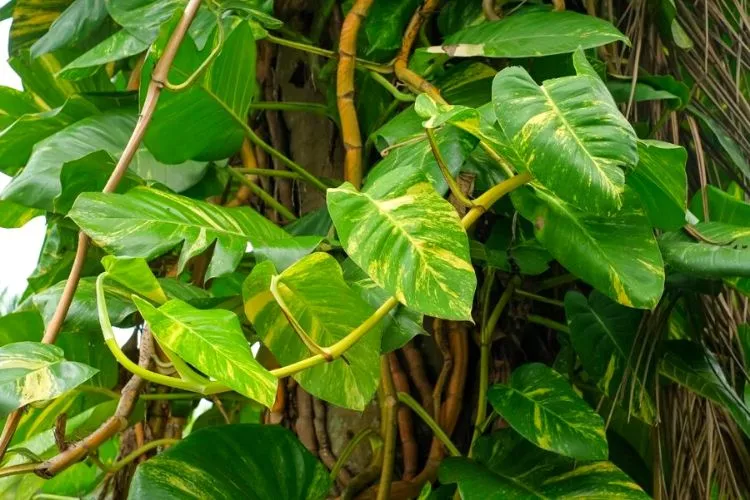
Pros
Bright and Natural Sunlight
When grown outside, pothos plants gain access to an abundance of natural and bright sunlight. Sunlight is a key element to photosynthesis, so bathing in the good stuff helps to promote healthy growth and development.
Natural sunlight provides the plant with much more “clean” energy than artificial light, leading to larger leaves and a fuller plant. Arguably, artificial light is at even par. However, natural sunlight simply cannot be matched 100%.
Better Chances of Growth
The excess space and access to natural resources found outdoors can significantly increase the chances of a pothos plant growth. They can enjoy the abundance of water and nutrients that the outdoors provides.
This abundance allows the plant to grow much larger, fuller, and faster. Not bad for a slight adjustment and scenery change.
Free Access to Rainwater
One of the biggest advantages of growing your pothos plant outside is having access to a free and almost unlimited amount of rainwater. This form of resource is often rich in nutrients and free from chemicals.
The beauty of rainwater is that it is considered “softer” than tap water, which can be more beneficial for the plant’s overall growth and health.
Nutrient-Rich Soil
By growing your pothos plants outside, you are allowing them access to soils much richer in naturally provided nutrients. This promotes healthy growth and development from root to tip.
Outdoor soil is usually enriched with naturally formed organic matter, providing the plant with abundant necessary nutrients needed to grow.
Fewer Fertilizers Needed
Another upside to growing pothos plants outside is that you don’t need to use as much fertilizer as you would with indoor plants. This is because the plant gets nutrients from its soil and rainwater. As a result, the need for any additional fertilizers is significantly reduced.
Zero Rootbound Worries
Lastly, when grown outside, pothos plants have much more space to grow and spread their roots. This helps them by reducing the chances of becoming rootbound. A plant that isn’t rootbound can absorb much more water and nutrients, leading to faster, healthier growth and development.
Cons
Sudden Temperature Fluctuations
One of the biggest issues with growing pothos plants outside is the sudden temperature fluctuations they can experience. This can affect the plant’s health and survival in several ways.
For example, if the temperature drops suddenly, it can lead to frost damage. Whereas sudden upswings of heat can make the plant wilt and dry out if left untreated.
Expose to Pests and Diseases
Another problem with growing pothos plants outside is the exposure they have to a range of different pests and diseases. This vulnerability can affect their overall health and chance of survival.
Routine inspection and prompt treatment are essential in the fight to help prevent any damage and ensure the plant’s survival.
Landscaping Changes
Lastly, when growing pothos plants outside, you may need minor landscaping tweaks to accommodate the plant’s growth and development. As the plant grows, it will climb, and the roots will spread underneath the ground.
In this case, they may require things like support structures, such as trellises or trainers. Furthermore, ensuring the plant has adequate space to spread its roots and leaves becomes a priority.
How to Prepare Pothos for Outdoor Living?
If you are planning to grow your pothos plant outside, here are some steps and tips to prepare it for outdoor living
Repotting Pothos Plant
If your pothos plant is growing in a small pot, you may find it’s time to repot it into something larger. Doing so will give your plant more space for its roots to grow and absorb nutrients when it does come time to repot, choose and use soil with adequate drainage.
A sandy loam or clay loam blend with some peat moss, perlite, and mixed compost works best. Adding a gravel or rocks layer at the pot’s bottom can also significantly improve drainage.
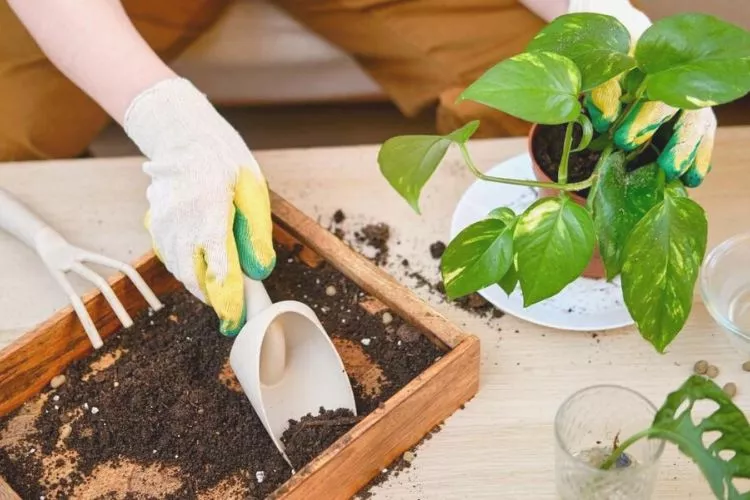
Let’s have a look at the best and simplest way to report a Pothos plant for outdoor living:
- Choose a larger container at least 2-3 inches wider than the current pot to allow for extra growth. Make sure the pot has adequate drainage holes at the bottom to prevent water from accumulating within the soil.
- Prepare the new pot by adding a layer of gravel or rocks at the base to improve drainage. These materials will stop any unnecessary clumping around the drainage holes. They act like a buffer.
- Mix a well-draining potting soil with perlite or sand to assist with drainage. Fill the new pot with the fresh soil mixture and leave a dug-out space at the top for the pothos plant to be slotted in.
- Carefully remove the pothos plant from its current pot by gently loosening the soil around the roots. Be careful not to damage the roots, as they can often be quite sensitive.
- Place the pothos plant in the dug out hole in the center of the new pot. Make sure the roots are spread out evenly so they can grow even and straight without any hindrance. Add more soil around the roots by gently pressing them down to remove air pockets.
- Water the plant thoroughly, making sure the soil is evenly moist. Then let any excess water drain out of the pot base.
- Place the newly potted pothos plant in a shaded or partially shaded area to acclimate to its new surroundings. Gradually increase the amount of sunlight it is exposed to over about a week or two.
Gradual Acclimation
When moving your pothos plant from inside your home to the outdoors, it’s important to acclimate the plant gradually to prevent plant shock. You can achieve this by first exposing the plant to outdoor light and temperature for a few hours each day. Then, gradually increase this exposure time over a week or two.
Proper Watering Schedule
A proper water schedule is essential for a pothos plant when growing outside. The biggest mistakes to avoid are over or under watering. The best way to counteract these issues is by only watering the plant when the soil feels dry. You should also try to allow as much excess water to drain out of the pot as possible.
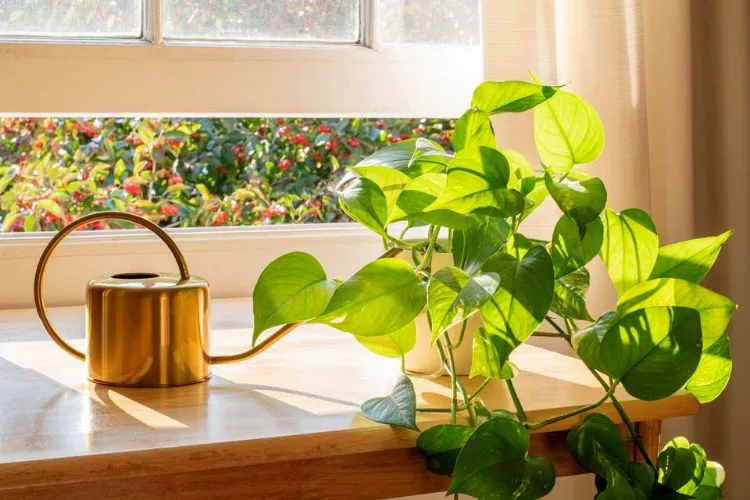
Overwatering should be avoided, as too much moisture can lead to root rot. When a pothos plant’s roots start to rot, they are difficult to correct and can lead to an early, unnecessary death.
Ideal Humidity and Sunlight Exposure
Pothos plants thrive best when the humidity levels range between moderate and high. They also appreciate bright, indirect sunlight. Therefore, placing them somewhere that they can be exposed to at least 6-8 hours of bright, indirect light per day is ideal.
You can increase the humidity by misting the leaves or placing a water tray near the plant.
Protection from Harsh Elements
When growing your pothos plant outside, it’s important to protect it from the environment’s harsh elements, such as wind and frost. We recommend using a protective cloth, a layer of mulch, some well shaped foam, or a plastic covering to shield the plant from strong winds or frost.
You can also move the plant to a protected area, such as a covered patio, garden shed, or even behind a wall that can act as a windbreak.
Fertilization
An outdoor pothos plant needs some supplementary plant food in the form of fertilization. This is essential in the promotion of healthy growth and development. Try using a well-balanced fertilizer with a 20-20-20 or 10-10-10 NPK ratio.
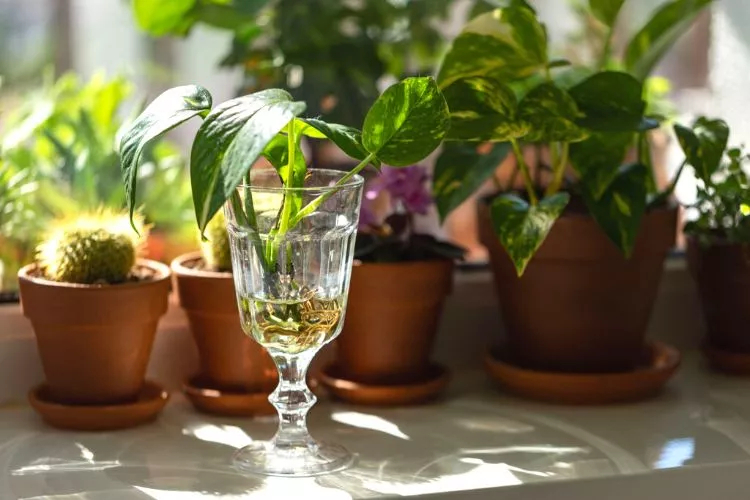
This fertilizer should be applied once a month during the plant growing season. You don’t need to use any fertilizer during the winter months as the plant is dormant now.
Pruning and Maintenance
Regular pruning and maintenance are essential to keeping your pothos plant healthy, happy, and thriving. Aim to prune the plant to remove dead, decaying, or damaged leaves or stems. This will encourage new growth in the springtime.
You can also give your plant a bit of a haircut as general maintenance to help control its size and shape. Always be on the lookout for signs of pests and/or diseases, and treat them promptly to prevent any long-term damage.
Common Problems and Solutions
Despite even the best of efforts, there is always the possibility of your pothos plant encountering some common problems when growing outside. Let’s have a look at some of the common problems and the solutions to keep your pothos plant healthy and thriving:
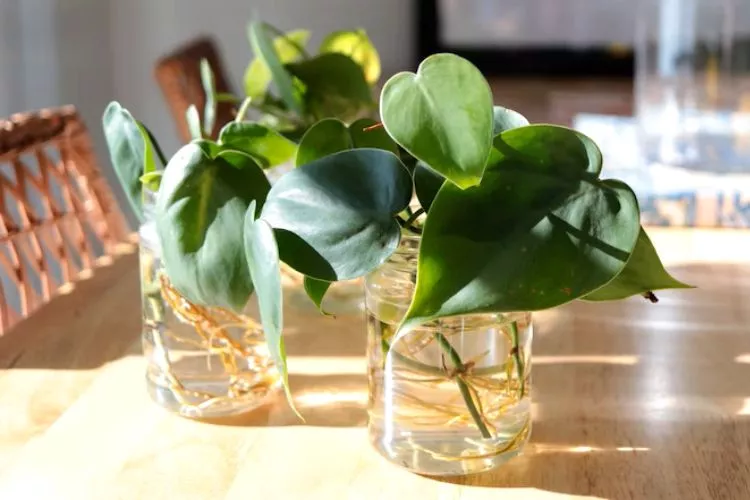
Root Rot
Root rot is the biggest problem as far as diseases are concerned for a pothos plant. This fungal disease affects the roots of the pothos plant. It is often caused by poor management in the form of overwatering or poorly draining soil. Root rot symptoms include yellowing leaves, wilting, and a foul smell.
To prevent root rot, you just need to ensure you are using well-draining soil and avoiding overwatering. If your plant is already showing signs of root rot, you may need to pull it up, remove any affected roots and repot it. Allow the soil to dry out between waterings.
Pest Infestations
The more common pests, such as spider mites and mealybugs, tend to infest your pothos plant more when growing outside. Their destruction causes damage to large portions of the leaves and stems. To prevent and treat pest infestations, regularly inspect your plant for signs of infestation and treat them promptly with insecticidal soap or neem oil spray.
You can also invite and use natural predators such as ladybugs to control the pest population. Planting flowers and herbs such as dill, fennel, coriander, yarrow, and marigolds near your pothos will help attract ladybugs to the area.
Sunburn
Prolonged exposure to direct sunlight can cause the leaves of your pothos to become scorched and burnt. As a result, they will start to turn yellow or brown. To prevent sunburn, provide your plant with bright, indirect sunlight but avoid placing it in direct sunlight during the hottest parts of the day.
Having them in pots will allow you to move them to a shaded area. Even using a protective cloth to shield it from the sun can be advantageous in decreasing heat exposure.
Nutrient Deficiencies
Nutrient deficiencies can also be problematic when it comes to the growth and development of your pothos plant. A lack of the right nutrients can cause symptoms such as yellowing leaves or stunted growth.
To prevent nutrient deficiencies from occurring, fertilize your plant regularly with a balanced fertilizer. You can also mix organic fertilizers such as compost or worm castings into your soil to give your plant the necessary nutrients.
Frequently Asked Questions (FAQs)
What temperature can pothos tolerate?
Pothos plants prefer temperatures between 60-85°F (16-29°C). They can tolerate temperatures as low as 50°F (10°C) and as high as 95°F (35°C). However, sudden temperature changes can stress the plant and affect its growth.
Can pothos live in direct sunlight?
Pothos plants can tolerate some direct sunlight, but too much can cause their leaves to scorch. Providing your pothos plant with bright, indirect, or filtered sunlight is best.
Does pothos grow better inside or outside?
Pothos plants can grow well indoors and outdoors as long as their basic needs are met. Growing them outside provides them with more natural light, access to rainwater, and a larger space to spread and grow.
How long does pothos live?
The lifespan of a pothos plant can vary, but with good care and maintenance, it can live for many years, sometimes up to a decade or more.
Conclusion:
In conclusion, growing pothos plants outside can be a great way to provide them with natural light and nutrient-rich soil.
However, it also comes with challenges, such as pest infestations and sudden temperature fluctuations. With the right preparation and care, your pothos plant can thrive outside. We hope this guide has provided valuable information to help you grow your pothos plant outside.


